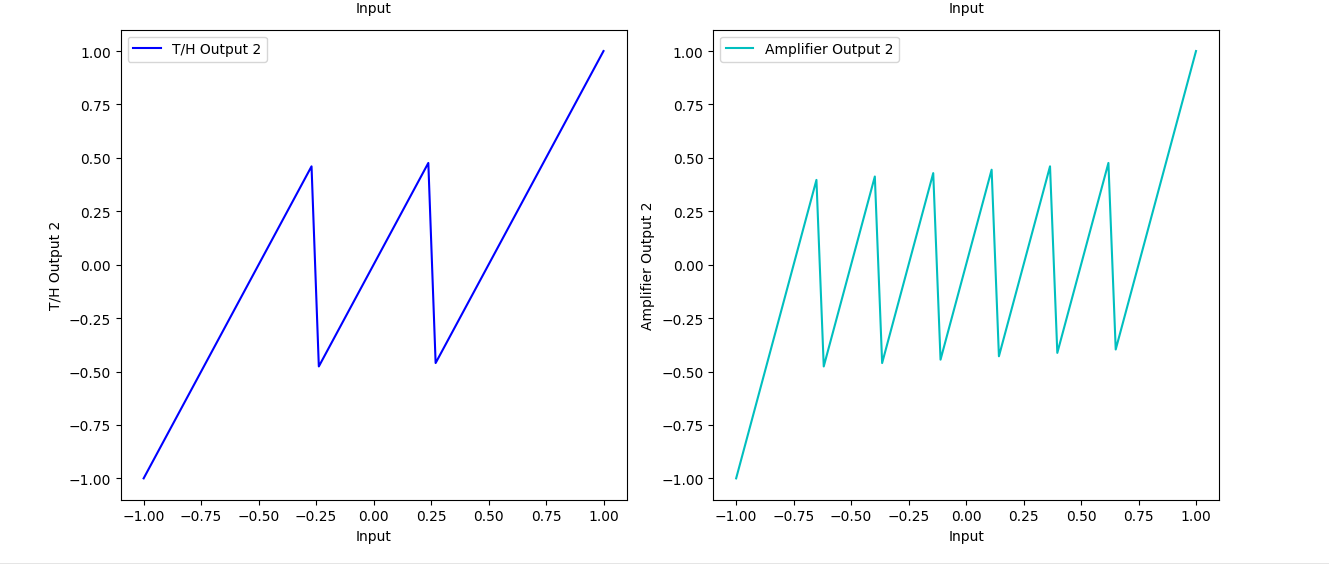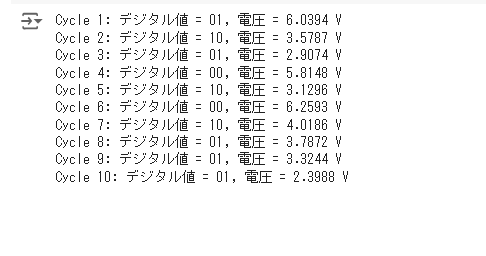def successive_approximation(Vref, Vin, N):
results = []
for i in range(N):
if Vin > 0:
MSB = 1
Vin = 2 * Vin - Vref
else:
MSB = 0
Vin = 2 * Vin + Vref
results.append((MSB, Vin))
print(f"Step {i+1}: MSB = {MSB}, Vin = {Vin}")
return results
# パラメータの設定
Vref = 10
Vin = 3.123321
N = 10
# 関数の実行
results = successive_approximation(Vref, Vin, N)
import numpy as np
import pandas as pd
import matplotlib.pyplot as plt
# Number of divisions
n = 64
# Generate input signal (range from -1 to 1)
input_signal = np.linspace(-1, 1, n)
# T/H circuit output (same as input)
th_output1 = input_signal
# ADC output with special thresholds
def adc_output(th_output):
return np.where(th_output <= -0.25, "00",
np.where(th_output < 0.25, "01", "10"))
adc_output1 = adc_output(th_output1)
# DAC output based on ADC output
def dac_output(adc_output):
return np.where(adc_output == "00", -0.5,
np.where(adc_output == "01", 0, 0.5))
dac_output1 = dac_output(adc_output1)
# Subtractor output
subtractor_output1 = th_output1 - dac_output1
# 2x amplifier output
amp_output1 = subtractor_output1 * 2
# Second stage
th_output2 = amp_output1
adc_output2 = adc_output(th_output2)
dac_output2 = dac_output(adc_output2)
subtractor_output2 = th_output2 - dac_output2
amp_output2 = subtractor_output2 * 2
# Create a DataFrame to hold all values for easy viewing
df = pd.DataFrame({
'Input': input_signal,
'TH Output 1': th_output1,
'ADC Output 1': adc_output1,
'DAC Output 1': dac_output1,
'Subtractor Output 1': subtractor_output1,
'Amplifier Output 1': amp_output1,
'TH Output 2': th_output2,
'ADC Output 2': adc_output2,
'DAC Output 2': dac_output2,
'Subtractor Output 2': subtractor_output2,
'Amplifier Output 2': amp_output2
})
# Print the DataFrame
print(df)
# Plotting the results
plt.figure(figsize=(12, 16))
plt.subplot(3, 2, 1)
plt.plot(input_signal, th_output1, label='T/H Output 1')
plt.xlabel('Input')
plt.ylabel('T/H Output 1')
plt.legend()
plt.subplot(3, 2, 2)
plt.plot(input_signal, dac_output1, label='DAC Output 1', color='r')
plt.xlabel('Input')
plt.ylabel('DAC Output 1')
plt.legend()
plt.subplot(3, 2, 3)
plt.plot(input_signal, subtractor_output1, label='Subtractor Output 1', color='g')
plt.xlabel('Input')
plt.ylabel('Subtractor Output 1')
plt.legend()
plt.subplot(3, 2, 4)
plt.plot(input_signal, amp_output1, label='Amplifier Output 1', color='m')
plt.xlabel('Input')
plt.ylabel('Amplifier Output 1')
plt.legend()
plt.subplot(3, 2, 5)
plt.plot(input_signal, th_output2, label='T/H Output 2', color='b')
plt.xlabel('Input')
plt.ylabel('T/H Output 2')
plt.legend()
plt.subplot(3, 2, 6)
plt.plot(input_signal, amp_output2, label='Amplifier Output 2', color='c')
plt.xlabel('Input')
plt.ylabel('Amplifier Output 2')
plt.legend()
plt.tight_layout()
plt.show()
import numpy as np
import pandas as pd
import matplotlib.pyplot as plt
# Number of divisions
n = 64
# Generate input signal (range from -1 to 1)
input_signal = np.linspace(-1, 1, n)
# T/H circuit output (same as input)
th_output1 = input_signal
# ADC output with special thresholds
def adc_output(th_output):
return np.where(th_output <= -0.25, "00",
np.where(th_output < 0.25, "01", "10"))
adc_output1 = adc_output(th_output1)
# DAC output based on ADC output
def dac_output(adc_output):
return np.where(adc_output == "00", -0.5,
np.where(adc_output == "01", 0, 0.5))
dac_output1 = dac_output(adc_output1)
# Subtractor output
subtractor_output1 = th_output1 - dac_output1
# 2x amplifier output
amp_output1 = subtractor_output1 * 2
# Create a DataFrame to hold all values for easy viewing
df = pd.DataFrame({
'Input': input_signal,
'TH Output 1': th_output1,
'ADC Output 1': adc_output1,
'DAC Output 1': dac_output1,
'Subtractor Output 1': subtractor_output1,
'Amplifier Output 1': amp_output1
})
# Print the DataFrame
print(df)
# Plotting the results
plt.figure(figsize=(12, 8))
plt.subplot(2, 2, 1)
plt.plot(input_signal, th_output1, label='T/H Output 1')
plt.xlabel('Input')
plt.ylabel('T/H Output 1')
plt.legend()
plt.subplot(2, 2, 2)
plt.plot(input_signal, dac_output1, label='DAC Output 1', color='r')
plt.xlabel('Input')
plt.ylabel('DAC Output 1')
plt.legend()
plt.subplot(2, 2, 3)
plt.plot(input_signal, subtractor_output1, label='Subtractor Output 1', color='g')
plt.xlabel('Input')
plt.ylabel('Subtractor Output 1')
plt.legend()
plt.subplot(2, 2, 4)
plt.plot(input_signal, amp_output1, label='Amplifier Output 1', color='m')
plt.xlabel('Input')
plt.ylabel('Amplifier Output 1')
plt.legend()
plt.tight_layout()
plt.show()
ランプ波
import numpy as np
import matplotlib.pyplot as plt
# Time parameters
T = 10 # total time in seconds
num_points = 1000 # number of points in the time array
# Create the time array
t = np.linspace(0, T, num_points)
# Ramp signal
V0 = np.linspace(0, 5, num_points)
# Reference voltage
VREF = 5
# Digital values
digital_values = np.zeros(num_points)
# Calculate digital values based on input voltage ranges
for i, V in enumerate(V0):
if V < 3 * VREF / 8:
digital_values[i] = 0 # Digital value 00
elif 3 * VREF / 8 <= V < 4 * VREF / 8:
digital_values[i] = 1 # Digital value 01
elif 4 * VREF / 8 <= V < 5 * VREF / 8:
digital_values[i] = 2 # Digital value 10
else:
digital_values[i] = 3 # Digital value 11
# Create labels for the digital values
digital_labels = {0: '00', 1: '01', 2: '10', 3: '11'}
# Plotting
fig, ax1 = plt.subplots()
color = 'tab:red'
ax1.set_xlabel('Time (s)')
ax1.set_ylabel('V0', color=color)
ax1.plot(t, V0, color=color)
ax1.tick_params(axis='y', labelcolor=color)
ax2 = ax1.twinx()
color = 'tab:blue'
ax2.set_ylabel('Digital Value', color=color)
ax2.plot(t, digital_values, color=color, linestyle='dashed')
ax2.tick_params(axis='y', labelcolor=color)
# Adding digital labels on the graph
for dv in np.unique(digital_values):
idx = np.where(digital_values == dv)[0]
ax2.fill_between(t[idx], digital_values[idx], color='tab:blue', alpha=0.1)
ax2.text(t[idx[len(idx)//2]], dv, digital_labels[dv], color='tab:blue',
ha='center', va='bottom', fontsize=10, bbox=dict(facecolor='white', alpha=0.5, edgecolor='none'))
fig.tight_layout()
plt.title('Ramp Signal and Digital Values')
plt.show()
V0 = 5.14467652 # 初期入力電圧
VREF = 8.5 # 基準電圧(適切に設定してください)
# サイクル数
N = 10
# サイクルごとのデジタル値と電圧を計算
def calculate_voltage(V0, VREF, N):
V = V0
results = []
for i in range(1, N + 1):
if 0 < V < (3 * VREF / 8):
digital_value = '00'
V = 2 * V
elif (3 * VREF / 8) <= V < (5 * VREF / 8):
digital_value = '01'
V = 2 * V - (VREF / 2)
elif (5 * VREF / 8) <= V:
digital_value = '10'
V = 2 * V - VREF
results.append((i, digital_value, V))
return results
# 計算結果を取得
results = calculate_voltage(V0, VREF, N)
# 結果を出力
for cycle, digital_value, voltage in results:
print(f"Cycle {cycle}: デジタル値 = {digital_value}, 電圧 = {voltage:.4f} V")
import numpy as np
import matplotlib.pyplot as plt
# Define periods
period1 = 10
period2 = period1 / 2
period3 = period1 / 4
period4 = period1 / 8
# Time axis (from 0 to period1 with step 0.001)
t = np.arange(0, period1, 0.001)
# Calculate clock signals (invert by using 1 - clk)
clk1 = 1 - (np.mod(t, period1) < period1 / 2).astype(int)
clk2 = 1 - (np.mod(t, period2) < period2 / 2).astype(int)
clk3 = 1 - (np.mod(t, period3) < period3 / 2).astype(int)
clk4 = 1 - (np.mod(t, period4) < period4 / 2).astype(int)
# Plot each clock signal separately
plt.figure(figsize=(10, 12))
# Clock 1 plot
plt.subplot(4, 1, 1)
plt.plot(t, clk1)
plt.title('Clock 1')
plt.xlabel('Time')
plt.ylabel('Signal State')
plt.ylim(-0.1, 1.1)
plt.grid(True)
# Clock 2 plot
plt.subplot(4, 1, 2)
plt.plot(t, clk2)
plt.title('Clock 2')
plt.xlabel('Time')
plt.ylabel('Signal State')
plt.ylim(-0.1, 1.1)
plt.grid(True)
# Clock 3 plot
plt.subplot(4, 1, 3)
plt.plot(t, clk3)
plt.title('Clock 3')
plt.xlabel('Time')
plt.ylabel('Signal State')
plt.ylim(-0.1, 1.1)
plt.grid(True)
# Clock 4 plot
plt.subplot(4, 1, 4)
plt.plot(t, clk4)
plt.title('Clock 4')
plt.xlabel('Time')
plt.ylabel('Signal State')
plt.ylim(-0.1, 1.1)
plt.grid(True)
# Adjust layout
plt.tight_layout()
plt.show()
def generate_digital_values(Vin1, VREF, stop_at=50):
digital_values = []
Vin = Vin1
# Initial MSB calculation
if Vin > VREF:
Vin_next = 2 * (Vin - VREF)
digital_values.append(1)
else:
Vin_next = 2 * Vin
digital_values.append(0)
print(f"Vin1 = {Vin:.5f}, Digital Value = {digital_values[0]}")
# Calculate subsequent MSBs up to stop_at
for i in range(2, stop_at + 1):
Vin = Vin_next
if Vin > VREF:
Vin_next = 2 * (Vin - VREF)
digital_values.append(1)
else:
Vin_next = 2 * Vin
digital_values.append(0)
print(f"Vin{i} = {Vin:.5f}, Digital Value = {digital_values[-1]}")
return digital_values
# Example usage:
VREF = 10.0
Vin1 = 3.77777
print(f"Reference Voltage (VREF) = {VREF} V")
print(f"Input Voltage (Vin1) = {Vin1} V")
digital_values = generate_digital_values(Vin1, VREF, stop_at=50)





